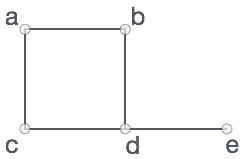- 数据结构和算法

图(Graphs)是一组对象的图形表示,其中一些对象通过链接连接,互连的对象由称为顶点的点表示,而连接这些顶点的链接称为边。在本章中,无涯教程将了解如何使用python程序创建图形并向其中添加各种数据元素。
使用python字典数据类型可以很容易地显示图形,将顶点表示为字典的键,并将顶点之间的连接也称为边作为字典中的值。

在上图中
V={a, b, c, d, e} E={ab, ac, bd, cd, de}
可以在python程序中显示此图,如下所示。
# 使用图形元素创建字典 graph={ "a" : ["b","c"], "b" : ["a", "d"], "c" : ["a", "d"], "d" : ["e"], "e" : ["d"] } #打印图 print(graph)
执行以上代码后,将产生以下输出-
{'c': ['a', 'd'], 'a': ['b', 'c'], 'e': ['d'], 'd': ['e'], 'b': ['a', 'd']}
显示图顶点
为了显示图顶点,简单地找到图字典的键使用keys()方法。
class graph: def __init__(self,gdict=None): if gdict is None: gdict=[] self.gdict=gdict # 获取字典的键 def getVertices(self): return list(self.gdict.keys()) # 使用图形元素创建字典 graph_elements={ "a" : ["b","c"], "b" : ["a", "d"], "c" : ["a", "d"], "d" : ["e"], "e" : ["d"] } g=graph(graph_elements) print(g.getVertices())
执行以上代码后,将产生以下输出-
['d', 'b', 'e', 'c', 'a']
显示图边缘
查找图边缘比顶点要难得多,因为必须找到在一对顶点之间具有边的每对顶点。 因此,无涯教程创建了一个空的边列表,然后迭代与每个顶点关联的边值。形成一个列表,其中包含 从顶点发现的不同边缘组。
class graph: def __init__(self,gdict=None): if gdict is None: gdict={} self.gdict=gdict def edges(self): return self.findedges() # 找到不同的边列表 def findedges(self): edgename=[] for vrtx in self.gdict: for nxtvrtx in self.gdict[vrtx]: if {nxtvrtx, vrtx} not in edgename: edgename.append({vrtx, nxtvrtx}) return edgename # 使用图形元素创建字典 graph_elements={ "a" : ["b","c"], "b" : ["a", "d"], "c" : ["a", "d"], "d" : ["e"], "e" : ["d"] } g=graph(graph_elements) print(g.edges())
执行以上代码后,将产生以下输出-
[{'b', 'a'}, {'b', 'd'}, {'e', 'd'}, {'a', 'c'}, {'c', 'd'}]
添加顶点
直接添加顶点是在图字典中添加另一个键的过程。
链接:https://www.learnfk.comhttps://www.learnfk.com/python-data-structure/python-graphs.html
来源:LearnFk无涯教程网
class graph: def __init__(self,gdict=None): if gdict is None: gdict={} self.gdict=gdict def getVertices(self): return list(self.gdict.keys()) #添加顶点作为键 def addVertex(self, vrtx): if vrtx not in self.gdict: self.gdict[vrtx]=[] #使用图形元素创建字典 graph_elements={ "a" : ["b","c"], "b" : ["a", "d"], "c" : ["a", "d"], "d" : ["e"], "e" : ["d"] } g=graph(graph_elements) g.addVertex("f") print(g.getVertices())
执行以上代码后,将产生以下输出-
['f', 'e', 'b', 'a', 'c','d']
添加边缘
将边缘添加到现有图形涉及将新顶点视为元组,并验证边缘是否已存在。如果没有,则添加边缘。
class graph: def __init__(self,gdict=None): if gdict is None: gdict={} self.gdict=gdict def edges(self): return self.findedges() # 添加新边 def AddEdge(self, edge): edge=set(edge) (vrtx1, vrtx2)=tuple(edge) if vrtx1 in self.gdict: self.gdict[vrtx1].append(vrtx2) else: self.gdict[vrtx1]=[vrtx2] # 列出边缘名称 def findedges(self): edgename=[] for vrtx in self.gdict: for nxtvrtx in self.gdict[vrtx]: if {nxtvrtx, vrtx} not in edgename: edgename.append({vrtx, nxtvrtx}) return edgename # 使用图形元素创建字典 graph_elements={ "a" : ["b","c"], "b" : ["a", "d"], "c" : ["a", "d"], "d" : ["e"], "e" : ["d"] } g=graph(graph_elements) g.AddEdge({'a','e'}) g.AddEdge({'a','c'}) print(g.edges())
执行以上代码后,将产生以下输出-
[{'e', 'd'}, {'b', 'a'}, {'b', 'd'}, {'a', 'c'}, {'a', 'e'}, {'c', 'd'}]
祝学习愉快!(内容编辑有误?请选中要编辑内容 -> 右键 -> 修改 -> 提交!)
 《Python数据结构入门教程》
《Python数据结构入门教程》 